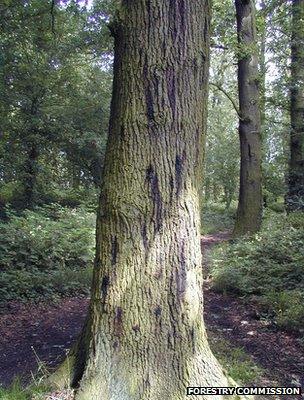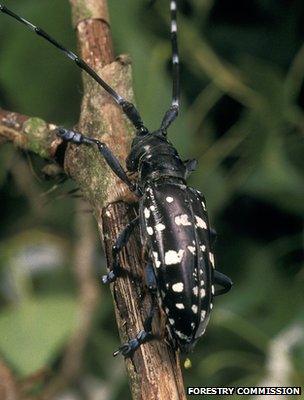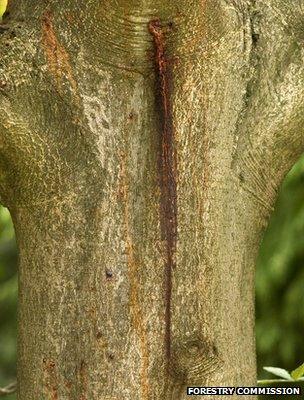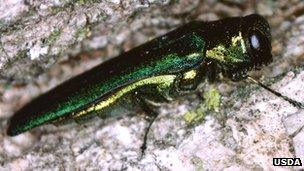Pest and disease threats to UK trees
- Published
UK tree species are facing growing threats from an increasing number of pests and diseases.
Below are some of the main threats to trees that have been recorded on these shores or are found in areas that make their introduction to the UK a real possibility.
Ash dieback (Chalara)

Chalara dieback of ash is described as "a serious disease of ash trees" caused by a fungus called Chalara fraxinea.
Symptoms include leaf loss and crown dieback in affected trees, and it can lead to tree death.
Ash trees suffering from symptoms likely to be caused by C. fraxinea are increasingly being found across Europe, including forest trees, urban trees in parks and gardens, and also nursery trees.
Control: Infected trees are felled and burned. People who think they have seen an infected tree can email the Forestry Commission's Plant Health Service.
Location: Case confirmed at nursery in Buckinghamshire in March 2012. In June 2012, nursery-supplied trees planted in a Leicestershire car park were found to be infected.
Chalara dieback of ash has been listed as a quarantine pathogen under national emergency measure and experts are urging people people to report suspected cases.
More information is available on the Forestry Commission's website, external.
Acute oak decline

Experts say symptoms include dark fluid bleeding from splits in the bark on oak tree trunks, and, as affected trees approach death, there is a notable deterioration of the tree's canopy and "dieback" of the branches.
Acute Oak Decline (AOD) is aggressive and can kill an infected tree in just four or five years. Tree experts fear it has the potential to change the face of the UK's countryside, similar to the impact of Dutch elm disease in the 1970s.
Scientists have identified a previously unknown bacterium, which they believe is playing a key role. They hope further research will lead to a better understanding of the disease, how it spreads, and what other factors might be involved.
Once researchers have a better understanding of the disease's dynamics, the data will be used to develop appropriate monitoring and management strategies.
Control: Scientists say that until more is known about AOD, there is no advice on treatment but a guide on how to manage affected trees, external has been produced.
Location: The disease has been recorded affecting hundreds of oaks in central and South-East England, and in parts of Wales.
More information is available on the Forestry Commission's website, external.
Asian longhorn beetle

Mature beetles emerge from late spring through to the autumn. Infected trees will have exit holes, about 10mm in diameter, in the tree's bark.
Adult beetles are large (20-40mm long), and their antennae can be up to twice the length of their bodies.
The larvae of the beetle can feed undetected inside the host plant. The grubs tunnel into wood, causing the tree to be weakened and susceptible to further pest and disease damage.
Adult beetles die soon after mating and laying eggs. The period from eggs being laid to the emergence of adult beetles can be several years.
The exotic pest is a threat to a range of UK broad-leaved trees and shrubs, including Acer (such as sycamore and maple), elm, horse chestnut, willow, poplar and birch.
Control: Infested trees are felled, and the felled material is incinerated.
Location: Currently, it has only been recorded in one woodland in Kent, South-East England. An infected tree (an ash-leaved maple) has been felled, and an inspection revealed that the larvae were still at an early stage suggesting that an adult beetle had only recently laid its eggs. This led to the "infestation zone" being extended. To date, 65 trees have been identified as being infested.
It is understood the beetle arrived in the UK via wooden packaging from China.
Scientists have warned that most of England and Wales, as well as warmer coastal areas of southern Scotland, may have the right conditions for the beetle to survive. But woodlands in southern England face the greatest risk.
More information is available on the Forestry Commission's website, external.
Horse chestnut bleeding canker

A bleeding canker on a tree appears as an area of dying bark that oozes liquid. Horse chestnut bleeding cankers are not new; for decades it was known that two fungus-like organisms causes these lesions, and they only occurred in low numbers. However, there has been a recent increase in infection rates.
Experts have identified that the new cases were being caused by a bacterium, Pseudomonas syringae pathovar aesculi, which had previously only been known to infect Indian horse chestnuts.
Control: No direct treatment is available. If a cankers spread around the entire trunk, it will cut off the food supply and the tree will die. Then, depending on its location, the tree will have to be felled.
General advice includes trying to plant trees of local provenance, as research shows that specimens grown from local seed stock are best adapted to local conditions, and have a better resistance to pests and diseases.
Location: Found in horse chestnuts all over the UK, with the greatest number within South-East England.
More information is available on the Forestry Commission's website, external.
Great spruce bark beetle

The Great spruce bark beetle (Dendroctonus micans) is deemed to be a major threat to spruce trees across Eurasia.
It breeds under the bark, destroys the cambium (a layer of growing tissue that produces new cells to carry water, sugars and nutrients around the tree). This weakens the tree, and in most extreme cases, the damage can kill the tree.
Control: Annual surveys around the edge of a quarantined area help identify infected trees, which are then destroyed. But researchers have a more effective tool in their armoury - releasing a natural predator.
A host-specific predatory beetle, Rhizophagus grandis, limits the spread of the bark beetle. This approach is known as "biological control". Researchers say this technique has been highly successful because of the predators' "extraordinary ability" to locate its prey, even when there may be only a few infested trees in the area.
Location: The beetle was first discovered in the UK in 1982 and was only recorded in western areas, mainly in Wales and adjoining English counties. However, an outbreak was discovered in Kent in 1996.
More information is available on the Forestry Commission's website, external.
Horse chestnut leaf miner

The horse chestnut leaf miner (Cameraria ohridella), a tiny moth, was first observed in Macedonia in 1985. In 1989, it appeared unexpectedly in Austria and has since spread throughout central and eastern Europe.
It was first recorded in the UK at a site in south-west London in 2002, but its range has expanded over the past few years.
Control: Experts say that there is no evidence that an infestation of the miner, on its own, causes dieback or a decline in tree health, or tree death. As a result, it is advised that there is no need to fell infected trees. The Forestry Commission says: "Even severely infested trees will re-flush as normal in the following spring."
The safest and most practical means of control is to remove fallen leaves during the autumn and winter. As the pupae spend the winter in the resulting leaf litter, commercial composting or burning destroys the pupae, reducing the moth population in the following spring.
A number of chemical insecticides have been shown to be effective in controlling the miner but they are difficult to apply, particularly to large trees and trees growing in urban areas.
Location: The miner is now found at sites throughout England and Wales.
More information is available on the Forestry Commission's website, external.
Phytophthora ramorum

The pathogen, described as "fungus-like", was first recorded in the UK in 2002 within the horticulture trade. In the following years, it was found in woodlands, parks and gardens. It is known to affect a number of species.
In 2009, it appeared on Japanese larch, an economically important timber species, in South-West England. It was the first recorded example in the world of Phytophthora ramorum infecting this species.
Experts say the symptoms to look out for on larch trees include dead and partially flushed trees present in groups, patches or distributed throughout a stand of trees; crown and branch dieback, with distinctive yellowing or ginger colour beneath the bark.
Control:Phytophthora ramorum is listed as a quarantine pathogen and infected plants are subject to strict biosecurity controls. This involves the infected individuals being felled and the appropriate disposal of the plant matter, such as burning.
Location: It is now found throughout the UK.
More information is available on the Forestry Commission's website, external.
Phytophthora lateralis

Phytophthora lateralis is a pathogen that kills the roots of its host trees. In the UK, it has been confirmed as infecting Lawson cypress trees (Chamaecyparis lawsoniana).
Above-ground symptoms on infected trees include dieback of the foliage, stem and collar lesions, with resin bleeding from stem lesions.
Lawson cypress is not a native species, and does not form part of any natural ecosystem. It is grown as an ornamental tree or is used in hedges.
The pathogen's growth temperature range is 3-25C (37-77F) and is able to survive in frozen plant matter for months, which means the UK's climatic conditions are favourable for the organism.
Control: Infected trees are felled and burned. Experts are confident that outbreaks in nurseries can be contained using similar biosecurity methods used to deal with other pathogens, such as Phytophthora ramorum.
However, they warn that the prospect of eradicating the pathogen from non-nursery situations is poor. A US study in 2000 found that once P. laterallis was established in a forestry situation, it was virtually impossible to eradicate.
Location: It was first recorded in Scotland in 2010, but is now present in Devon, Yorkshire and Northern Ireland.
More information is available on the Forestry Commission's website, external.
Emerald Ash borer

The bright green beetle is a major pest in North America, where it has been decimating ash trees for a decade. Native to Asia, it was understood to have been introduced to the US via contaminated wooden packaging.
Ash trees are an important economic timber in the US and damage from the borer could cost billions of dollars.
Symptoms are difficult to spot until the symptoms become severe. They include: thinning or yellowing of foliage; bark fissures measuring 5-10cm; woodpecker activity because the birds strip away small patches of bark in order to extract the borers; and D-shaped holes about 3mm in diameter.
Control: Insecticides can be used to control the spread of emerald ash borers (EAB), however as the pest lives under an infected tree's bark it is difficult to effectively apply these kinds of chemicals. Another option is to used soil-applied insecticides, which are absorbed into a tree via its root system.
Location: EAB's natural range includes eastern Russia, northern China, Japan and Korea. Since becoming established in North America in 2002, the beetle is now found across northern eastern US states and in a number of Canadian provinces.
Although EAB has not been recorded in Europe, a recent infestation near Moscow - as well as close trade links with the US and Canada- means the species is closely monitored by European experts.
More information is available on the Forestry Commission's website, external and on the United States Department of Agriculture's website, external.
- Published3 September 2012
- Published14 September 2011
- Published20 October 2011
- Published28 April 2010
- Published21 April 2010
- Published1 April 2012